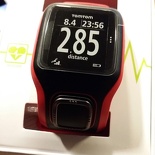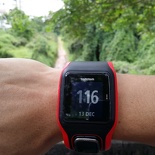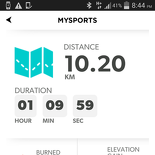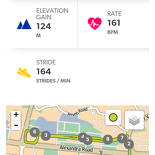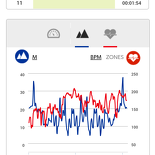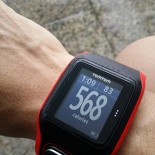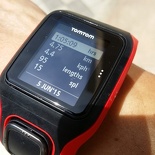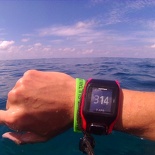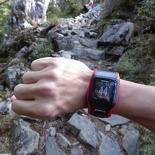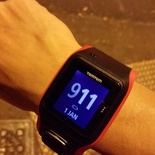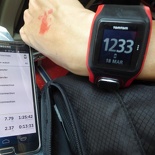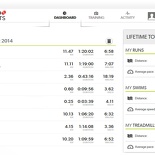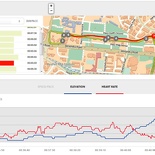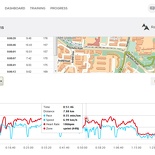The TomTom multi sport cardio watch is one of the few advanced all-in-one running computers available in the market today. The brand we come to know synonymous in in-car GPS navigation systems had expanded their product line into the now-hugely popular fitness tracker market. The device comprises of an integrated heart rate (HR) monitor together with GPS tracking all in a handy watch package on your wrist. With the miniaturization of handheld wrist GPS units for speed, distance and pace measurement, gone are the days of accelerometer based foot-pods typical seen on running computers of the yesteryear.
Being an avid Polar user for a good 10 years, my biggest gripe of the past having separate devices for speed/distance and HR is the hassle of managing these individual devices- batteries and the all-often disconnection during your activities. Having all the devices in one small compact handy package was a great welcome and jumping ship with my purchase of the TomTom (Retails at $449- $499 SGD) was quite a no-brainer.
The closet competition to the Multi-sport cardio will be the Polar M400, Soleus GPS Pulse and the more expensive Garmin 920XT. All similarly offer GPS tracking, but requires an external heart rate monitor strap. The Garmin 920XT does cost more of a premium and Soleus is a brand largely unheard to many if you compare to the likes of Polar, Timex or even Sunomo, but had been in the running for a number of years.
A Multi-sport jack of all trades
Calling these running computers does not seem to bring justice to the myriad of features offered by the device. These integrated devices are triathlon-capable devices, allowing for the measurement of sports telemetry for both swim and cycling activities. The TomTom multi-sport is no different. The watch is clad in sporty-looking shock-resistant gel wrist strap which is user-replaceable in a variety of colours.
The multi-sport does not have a touchscreen and all controls are accessible via a front-facing D-pad which is rather intuitive with well-labelled menus. In standby mode, the watch displays current day of the month, month and time either in 12hr or 24hr mode, the layout is simplistic, and lacks display of a second counter or even the day of the week. There are no options in the settings menu to customize the layout interface, though I wish it could be possible for TomTom to rectify this and allow layout customisations and additional clock layouts (digital or analog layouts will be nice) on subsequent firmware updates.
Outdoor running and Treadmill activities
Running is what the TomTom multi-sport excels as a sports watch, it can track concurrently not only your GPS coordinates but your HR too. The wrist HR sensor is self-illuminated by a green LED and stays on when you start your activity. The watch gives you prompters based on your workout intensity (current HR), for example, recommending you to warm up if it detects a low HR or measuring how fast your HR drops on cool down after a run to gauge the quality of your exercise recovery. GPS lock-on however, when with quick-GPS enabled takes a rather long time- up to 15 minutes. At times I start my watch running activity way before my pre-run warm up, and I will still be waiting after thereafter for the watch to get a lock-on before I can start running.
Duration your run activity, it can show you total GPS elapsed distance, as well as instantaneous speed and pace, which is good if you are planning to keep a minimum workout intensity of race pace and still works fairly well even when you go indoors after eventually getting a GPS lock. When indoors, the watch will revert to its internal accelerometers to gauge your pace and traveled distances. GPS tracking is good in covered and forested areas. You can also set the watch to vibrate/warn if your HR or speed drops below a certain set level. One of the cool but rather gimmicky features is the “Race” (Race shadow) function where you can race a shadow of yourself using any of your saved historical running data. The GPS distance tracking is fairly accurate and falls within 5% of my calibrated known distance on my usual running routes and using Satellite imagery, it tracks the altitude of your runs too, which I tested by bringing the watch up on my mountain climb in Taiwan.
Mountain climb
The watch has a treadmill mode which uses accelerometers to determine your current speed distance and pace; it is not really accurate given greater tendency for drift, falling within 80% of the distance measured on the treadmill itself.
Swimming Functionality
In swim mode, the Multi-sport cardio provides lap count and speed telemetry data in-activity. You need to specify your pool length (25/50m), goals intervals and target laps based on time, distance, average speed before starting out. Many features available in running mode are disabled in swim mode. For instance, the Multi-sport does not utilise its GPS or HR monitor in swim mode, but instead uses a set of integrated accelerometers to detect swim strokes count, and your turns in the pool. As said, the watch does a lap increment each time its accelerometers detect a sudden change in swim direction. The lap counts in my test are has varying accuracy based on the type of swimming strokes. It is 90% accurate for free style, but tends to double count breast stroke laps. Sometimes you also get a double lap count if you touch the pool wall at the end of the lap, just be sure not to use your watch-bearing hand for it.
However, the Multi-sport does not offer an open water swim mode, a feature you will have to give the Garmin forerunner 920XT for, but if you are doing most of your swims in a pool, the watch is more than adequate for your needs. There is no option to have HR monitoring in swim mode, a workaround for this now is to swim in the “Treadmill activity”, it’s accurate, but you forgo SWOLF, laps, etc. The watch is also waterproof to 50m, something I verified scuba diving with it up to 30m surviving without any problems. The TomTom is no scuba diving watch and when tracking my dive activity, was unable to get any GPS lock on the moment you go beyond 1m underwater.
Cycling Functionality
Another area where the watch shines is its cycling mode. The watch comes with removable strap which can be bike-handlebar mountable, though I tend to prefer having the watch worn on my wrist so I can get vibration distance alerts as well as HR monitoring. The multi-sport in cycle-mode provides the usual full suite of information at your disposal which you can display over the watch 3 field areas, such as instantaneous speed, cadence and calories. The watch also tracks your entire cycle route which you can download and review later. There are options to pair a TomTom cadence + speed sensor via the watch integrated Bluetooth, forgoing the need for installing and wiring up sensors up to the handlebar, the watch however, does not support ANT+ sensors, which is a shame. Like having to enter pool length parameters for the swim activity, you need to specify your bicycle wheel diameter manually in the watch cycle parameters to get speed from the sensor, though I personally recommend just using the GPS speed, forgoing the need to calibrate your sensors over a range of bicycle sizes.
Though the multi-sport has easily navigable menus, there are very limited information/race metrics which can be displayed in-activity. Only 3 types of information can be displayed at any one time, with the option to emphasize one data type at the centre of the display and others rotatable via the d-pad. I found myself putting Clock, distance/swim laps and speed/pace (main) as my main data, though it will be good to have an option for an additional 4th line for HR display especially in running mode: e.g. Speed, HR, Distance and Time providing all info on one screen at one glance on your run.
There is also no triathlon race mode in the Multi-sport, like that on the Garmin 920XT, as such getting to each of these modes require you to manually exit the current mode and start the next mode through the menus- not something you have the luxury of doing in a race. Though Garmin is a far superior watch with its 4 colour screen, far more advanced triathlon watch, but is priced about $200 SGD more.
Fair Battery life
From a full overnight charge, a 120 min hour run with GPS and HRM on and a 90 min swim brought the battery down to about a 50% charge, where, left on standby on my non-training days for the rest of the week lasts a full week before going flat . As such, I can say the watch is good for a single marathon event, or even a standard Triathlon with the HR monitoring on throughout. Based on the watch update rate in-run, pace and HRM is updated every second on the screen, which I assume is the default telemetry poll rate of the watch. It will be good to allow the user to specify the refresh intervals (e.g. 1s, 5s, 10s) depending on the activity sport type for battery endurance and longer runs. I reckon the watch may just have enough battery charge for a full Ironman.
Bluetooth, sync and Gripes
The multisport is well supported by a mobile app and website allowing you to review your exercises. All information stored on the watch can be synced via Bluetooth direct to your phone instead of a computer. There are however, few glaring features which are lacking in the Cardio watch, considering how feature packed and capable the watch is. Despite having Bluetooth connectivity to your phone, the multi-sport does not feature phone Bluetooth message notifications, neither does it has activity day tracker functionality (steps/distance) function.
It is also exceptionally easy to accidentally set the watch backlight ON, even a simple brush on the side of the watch turns the backlight on. You can activate the but since the watch runs off there is not much a worry of draining expensive cell batteries typically found on legacy running computers . It might be good for TomTom to set a capacitive screen hold period of maybe 1-2 seconds instead of the current <0.5s to turn it on.
You can store a limited amount of activities (depending on duration of data collected) before having to sync to clear the internal memory. I will need to sync every 2 months at a time with about 2000 minutes of activities before running out of storage space for new activities, data space is limited not by number of activities, but rather the duration of the activity, where more telemetry data needs to be stored. Syncing your exercises will remove the stored activities on your watch. The proprietary USB dock also does data sync (faster than Bluetooth) and charging which is convenient for travel instead of having to lug a proprietary power brick around.
In addition to accessing your running data on the mobile app, you can review them too on Tomtom website after logging in using your MySports account, allowing you to review your activities in more detail. Here get telemetry graphs with respect to time of all your saved activities, as well as GPS plots on google maps which I found really good in summarizing and planning your future activities.
In all, the Tomtom multi-sport is a very well featured watch delivered in a trendy contemporary package. It has its flaws, but is still otherwise very well priced for what it can offer. The watch is one of the best integrated fitness watches you can buy now.
Pros
- Good 1 week battery life
- Full multi-sport functions
- Excellent 50m water resistance
- Well supported by mobile and web-apps
- Accurate real-time GPS tracking
- Trendy replaceable straps with variety of colour choices
Cons
- No day and second hand timer on watch
- Limited screen display fields
- Long GPS lock duration
- Slow Bluetooth connectivity
- No daily activity tracker
- Hyper-active backlight

